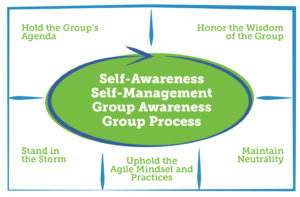What is courage?
cour.age
– the ability to do something that frightens one
In chapter 6 of my book “The Art & Science of Facilitation” we discuss ‘Developing and Mastering your Facilitation Stance’.
What the title of chapter 6 doesn’t spell out is that you, the facilitator, have to find your own source of courage. Courage to say what you see, to inquire about difficult subjects, to not walk past the elephant in the room.
It Takes Courage To Lead!
If finding courage in leadership and facilitation is something you are actively seeking, start here:
The five cornerstones of the Agile Team Facilitation Stance explained
How to gain true mastery in Agile Team Coaching
About leadership, horses and the importance of trust
How to gain agility by giving up control
Each of these articles from the TeamCatapult blog touch on courage.
Courage is needed when leading.
What’s at the heart of wisdom is candor, honesty, authenticity, and vulnerability. In other words, being a real human being who is tapped into their inner wisdom. Teamwork and facilitation is not for the faint of heart. Tools, structures, agendas, and post-it notes only get you so far. We all have to do the rest, individually and together!
Building Self-Awareness and Self-Management
The process of self-awareness and group awareness is always on-going. There is a natural progression, an unfolding, in developing your ability to stand confidently in all five cornerstones of your facilitation stance while in the moment.
These five principles include:
- Maintaining Neutrality
- Standing in the Storm
- Honoring the wisdom of the group
- Holding the Group’s Agenda
- Upholding the Agile Mindset and Practices
To learn more about each of the guiding principles, I invite you to check out my book “The Art & Science of Facilitation” in which I’ve dedicated one chapter to each of the five principles.
How to Get Clarity and Be Grounded in Your Own Practice
I’d like to give you 7 lessons to help you with the self-work needed for facilitation, lessons that will be on-going throughout your career.
1 Work with a Co-Facilitator
One of the best ways to get better at the practice of facilitation is to co-facilitate!
2 Start a journaling practice and ask yourself tough questions
Journal after each time you facilitate. You will start noticing patterns in your facilitation behaviors and default actions, which will deepen your self-awareness in the room.
3 Change “roles” in order to share your opinions and perspectives
The trick to sharing your opinions and perspectives is learning to share in a way that does not make you right and the team wrong.
4 Work with a supervisor
No matter how developed your practice, your facilitation skills can always be deepened through outside perspective.
5 Intervene to break patterns
Sometimes what a group needs is something to disrupt their familiar habit. Yet disrupting habits, naming things that the group is unaware of, or surfacing topics that they might not want to address come with high stakes – for you, and for them.
6 Articulate what’s happening in the group
Being neutral does not mean that you are passively standing by and watching. When you have the impulse to jump into the content, practice using your model for team dynamics. Name what you see, without judgement.
7 Develop your model for facilitation
The notion of model building, applies to you in your facilitation practice as well! As you practice, you will begin to feel constrained by some of the guidance offered. It’s a good indicator that you’re ready to define your one stance for facilitation!
My Final Word of Guidance
As you embark upon the journey of facilitation, remember that responsibility in facilitation means owning your part and helping the group own theirs!

